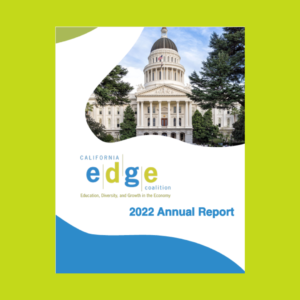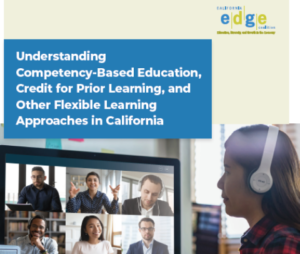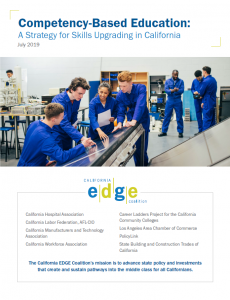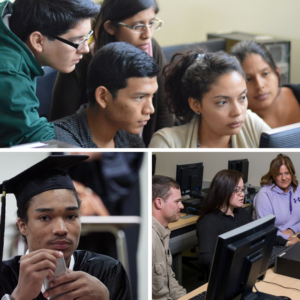
2022 Annual Report
Dear Friends, California has a staggering number of unfilled good jobs and an incredible pool of talent living in poverty or below a living wage.
The mission of the Adult Education Program (AEP) is preparing adult learners for college, career, and civic responsibility by providing them the literacy, mathematics, and technical skills they need to succeed.
This installment of the Workforce Brief Series titled “Adult Education” describes the challenges and opportunities presented to California’s Adult Education Program as regards funding and consistent accountability metrics. To learn more, download the full text of the article here.
Historically, roughly 90 percent of funding for the AEP came from the state’s General Fund; the rest was from Title II of the federal Workforce Investment Act (WIA). In 2007-08, the AEP received $754 million from the General Fund and $77 million from WIA. The February 2009 Budget Act cut the state funding and made a dramatic change, giving local school districts the ability to use AEP funds for other educational programs from 2008-09 through 2012-13, which was recently extended through 2014-15. With this
flexibility option, a significant share of state funds has been shifted to K-12. Total state funding available to local AEPs has declined to under $400 million in 2009-10 and continues to erode annually.
However, the WIA II funding, based largely on the state’s population lacking high school diplomas, provides a measure of relief to local educational programs with $87.6 million in 2011-12.

2007 / 2008 State General Fund
2007 / 2008 State General Fund
2007 / 2008 State General Fund
2007 / 2008 State General Fund
California workers earning less then $13.63 per hour
The AEP accountability system, mandated for WIA recipients by the federal government, measures student progress in completing 11 literacy levels within a single program year. Since many adult education programs are open entry/open exit, students counted in any one year could have been in the program for only a short time or as long as one year. The current system does not facilitate tracking of students across program years or from one school to another. The AEP reporting system is not linked to that of the community colleges, so AEP students cannot be tracked into higher education. Both of these issues can be overcome when the AEP has access to the Statewide Student Identifiers (SSID) and the California Longitudinal Pupil Achievement Data System (CALPADS) that are currently available for K-12 students. Because Social Security numbers are not used to identify students, they currently cannot be tracked into the labor market.
The AEP serves high school dropouts and other adults returning to school – many of them immigrants. All federal WIA and most AEP students are enrolled in basic skills such as reading and writing, mathematics, or English as a Second Language (ESL) courses. Some AEP students are enrolled in additional subjects to complete their GED certificates or high school diploma requirements. ESL students comprise approximately half of the AEP basic skills enrollment and two-thirds of all students in the federal basic skills programs; of these, more than a quarter are at the beginning ESL level. The other major AEP enrollment area is career technical education (CTE) serving 94,500 students. In addition to basic skills and CTE, the AEP has served older adults and adults withdisabilities, and provides courses in citizenship preparation, health and safety, home economics, and parenting. However, since the 2009 budget bill, local districts have focused more sharply on basic skills and CTE. The total number of AEP students served has declined since enactment of the 2009 budget bill, from a total of 1.24 million students in 2007-08 to 776,850 students in 2009-10.

Dear Friends, California has a staggering number of unfilled good jobs and an incredible pool of talent living in poverty or below a living wage.

EDGE recently partnered with the California Association of Alcohol and Drug Program Executives (CAADPE) to publish a new report, Identifying Barriers to Employment After Substance

Dear Friend, I’m excited to bring you the first annual State of the California EDGE Coalition Report intended to provide you with an overview of our successes

Postsecondary credential attainment is a primary path to economic and social mobility. However, more than 5.5 million Californian adults have some college but no degree and are no longer enrolled. For millions more who are juggling personal and work responsibilities, fitting college into an already hectic life seems impossible.

. A new policy brief released by the California EDGE Coalition examines the ways in which other states are now successfully employing competency-based approaches to teaching and learning which allow students to move flexibly – and often much more quickly – through an educational program that is designed to make sure they know and can do what is expected of graduates.

Many Californians face significant financial, educational and navigational barriers to completing the education and training they need to succeed in today’s labor market. Read our latest publication, Making Certificate and Degree Completion More Affordable and Accessible for Low-Wage Workers